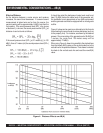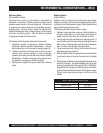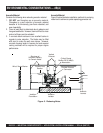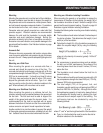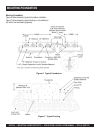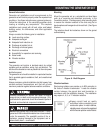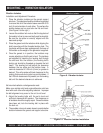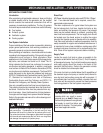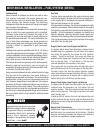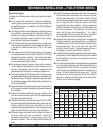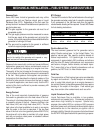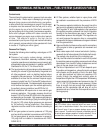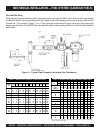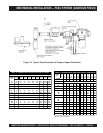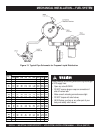
PAGE 38 — INDUSTRIAL GENERATOR SETS — APPLICATION & INSTALLATION MANUAL — REV. #4 (09/07/07)
MECHANICAL INSTALLATION — FUEL SYSTEM (DIESEL)
Subbase Tank
Base mounted or subbase fuel tanks are used to store
fuel directly underneath the engine-generator set,
eliminating the need for a remote main fuel supply tank
and/or auxiliary fuel transfer pumps. This mounting
arrangement offers the convenience of having a fuel supply
tank mounted at the generator.
These tanks are designed to be contained in a rectangular
base on which the engine-generator set is mounted.
Generally, these tanks only increase the height of the
generator set since the tank base is usually matched to
the generator skid dimension. For many installations, this
type of tank offers advantages over above ground and
below ground tanks due to stringent environmental laws
making it difficult or impossible to gain necessary
approvals.
Subbase fuel tanks are available with the UL142 listing
under the special purpose tank category of NFPA. These
tanks are available in various capacities and designs. When
a subbase fuel tank is used, the tank should be designed
with a stub-up area on the generator-end of the tank.
This feature allows for an open area on the tank assembly
whereby electrical terminations can be brought up
underneath the engine-generator for final termination (refer
to Electrical Connections section).
Day Tank
Fuel day tanks are used when the engine fuel pump does
not have the capacity to draw the fuel from the supply tank;
or the supply tank is overhead and presents problems of
high fuel head pressure for the system.
In high ambient conditions, the day tank temperature might
need to be considered. Warm fuel returning from the engine
fuel injection pump should not be returned to the day tank if
possible. As fuel temperature increases, fuel density and
lubricity decrease, reducing maximum power output and
lubrication of fuel handling parts such as pumps and injectors.
This
may
be avoided by returning the fuel back to the supply
tank rather than the day tank.
Supply Tank Lower than Engine Installation
If a supply tank is lower than the engine, the day tank is
installed near the generator set and within the engine
fuel pump lift capability, but below the fuel injection
system. Install an auxiliary fuel pump as close as
possible to the supply tank to pump fuel from the supply
tank to the day tank. A float switch in the day tank
controls operation of the auxiliary fuel pump.
The supply tank top must be below the day tank top to
prevent siphoning from the fuel supply to the day tank.
Provide a return line from the engine injection system
return connection to the day tank (near the top). Provide
a day tank overflow line to supply tank in case the float
switch fails to shut off the fuel transfer pump.
Using oversized subbase fuel tanks, where the tank is larger
than the skid of the generator, can cause difficulty in
completing final electrical connections. The tank should be
designed with a stub-up area on the generator-end of the
tank. However, depending on the placement of the engine-
generator on the tank, feeder terminations may not rise in a
close proximity to the circuit breaker. This could require the
feeder conductors to enter the circuit breaker enclosure from
the side or top, necessitating special fittings and/or hardware.
Be sure to check with the local inspection authority before
proceeding.
Supply Tank Higher than Engine Installation
If a supply tank is higher than the engine, the day tank is
installed near the generator set, but below the fuel
injection system. Fuel lines should at least be as large
as the fuel pump inlet. The engine fuel return line must
enter the day tank.
Include a shut-off valve in the fuel line between the fuel
supply tank and the day tank to stop fuel flow when the
generator set is not in use and the battery is disconnected
(Off Mode).
Engine Fuel Connections
Identification tags are attached to the fuel supply line
and fuel return line connections by the factory. Flexible
lines for connecting between the engine and stationary
fuel line are supplied as standard equipment.
Failure to provide an overflow line to the
supply tank from the day tank can cause
spilled fuel, safety hazards, and damage
to equipment. Wipe up any spilled fuel
immediately. Spilled fuel if ignited can
cause a fire or explosion, causing
damage to the equipment and severe
bodily harm — even
death!



